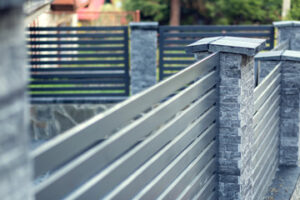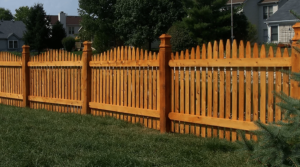A well-maintained privacy fence elevates property value and increases your family’s quality of life. It can also help you reclaim the serenity you imagined when purchasing your home.

Traditional dog-ear pickets and other wood privacy fence designs greet the outside world with a smile, creating a consistent visual flow. In other cases, orienting the structural side outward can benefit utility and cost efficiency. Learn More Here by reading the article below.
If you have a beautiful backyard, it’s a good idea to showcase it by having your privacy fence built in such a way that it highlights the beauty of your landscaping. A beautiful yard is a major selling point for property and often the first thing homebuyers notice when browsing properties online before visiting their new homes in person.
Aside from the obvious benefits of creating a private oasis on your own property, having a well-built privacy fence is also a great way to enhance your curb appeal. With its elegant appearance and stately design, this type of fencing is a perfect complement to traditional or colonial-style homes. Moreover, a solid-board privacy fence is ideal for homeowners who value security and privacy since it offers an extra layer of seclusion that’s harder to breach than other types of fencing.
The direction your privacy fence faces impacts more than just aesthetics; it can also influence neighborhood dynamics, security, and even property values. In most communities, standard practice dictates that the finished side of a privacy fence should face outward to maintain a uniform and appealing visual landscape that benefits everyone in the community. This simple gesture demonstrates good etiquette and can help reduce the chance of disputes between neighbors.
It’s important to do your research and understand your limitations before hiring a contractor to build your privacy fence. Check if your neighborhood has any HOA guidelines, building codes or other restrictions that can affect the type of fence you can build and its height. Some projects may require zoning permits, especially for fences that are taller than 6 feet.
Once your privacy fence is complete, it’s important to protect and preserve it by applying a preservative treatment to the surface of your wood. Another great option to consider is adding a decorative post cap, which will add a finishing touch to your fence. Aside from protecting the posts from weather damage, they also offer an attractive look that will make your privacy fence more stylish and appealing to the eye.
Privacy
A privacy fence is designed to protect your home and yard from nosy neighbors and passersby. If you are tired of people looking at your property or walking into your yard, a new fence can provide the privacy you need to enjoy your backyard. Privacy fences are usually higher than other types of fences and they come in many different styles to suit your home’s design and landscaping.
Wooden fences are a popular choice for homeowners who want to add privacy to their homes. They can be made from a variety of materials, including cedar, wrought iron, and pressure-treated wood. Each type of material has its own pros and cons, so it is important to consider your needs and budget when choosing a wooden fence.
If you’re looking for a more modern look, consider a steel or aluminum privacy fence. These fences are lightweight and durable, so they’ll stand up to the elements without warping or bending. They also offer the added benefit of reducing noise pollution around your home, making your backyard a quiet place to relax.
Luxury vinyl fences are available in a wide range of styles and colors, so you can find the perfect one to complement your home. These fences are durable and low-maintenance, so they’ll last for decades without losing their original color or requiring extensive repair.
Another reason to choose a vinyl privacy fence is that it can help to improve your home’s security. While it won’t stop a dedicated thief, it will deter trespassers and other potential threats. If you have children or pets, a privacy fence will also help to keep them from running out into the street or exploring the neighborhood.
By placing the structural side of your privacy fence inward, you can reduce climbing opportunities for trespassers or children. This feature makes your privacy fence harder to climb and can add an extra layer of protection to your home.
When homeowners in a community follow the tradition of facing the finished side of their fences outward, it shows consideration for their neighbors and contributes to a unified, attractive visual landscape. This small gesture can promote peace and goodwill in the neighborhood and may even be required by local ordinances.
Security
Privacy fences don’t just keep out prying eyes, they also offer a strong deterrent for unwanted human and animal visitors. This solid barrier helps to keep children and pets safely within bounds, keeps unwelcome critters away from tender garden plants, and protects your home from intruders and vandals. Many homeowners choose wood fences because they blend well with the natural surroundings, are naturally resistant to pests, and can be stained or painted to match home aesthetics. Metal fences like wrought iron offer a classic and sophisticated style that is both powerful and secure.
In addition to offering a solid barrier, a privacy fence acts as a visual deterrent for intruders because it blocks the view of what’s inside. That’s one of the reasons why a privacy fence is such a popular choice for homes with small children and pets. It’s also a great option for people who want to make their yards less attractive to burglars.
If you don’t want to invest in a full-fledged privacy fence, try adding some lattice on top of your existing fence to provide an extra level of security without blocking all visibility. You can even use the lattice to increase your fence’s height from the standard six feet to eight feet. Some areas require that your fence be no taller than six feet, so this is a way to still have some protection without violating local regulations.
Regardless of the material you choose for your privacy fence, it’s important to ensure that it is constructed properly and regularly maintained. The best way to do this is to hire a professional to do the job. They can check for loose or damaged fasteners and repair them as necessary, which will help to prevent the fence from becoming unstable over time. It’s also a good idea to apply a sealant on your wooden privacy fence to protect it from water damage and UV rays, and to prevent it from fading or staining over time.
The direction that your privacy fence faces impacts more than just its appearance, and it’s often mandated by local ordinances for uniformity. In most cases, it’s preferable to have the finished side face outward, as this shows consideration for neighbors and visitors by presenting a unified and attractive appearance. In some instances, it may be better to have the structural side face outward, however, as this could facilitate vines and other decorative components that can enhance the overall look of the fence.
Maintenance
A privacy fence provides a barrier that prevents people and animals from wandering onto your property. This safety feature protects children and pets from stray vehicles, and it deters criminal activity, making your home a safer place for your family to live. Inspect your privacy fence regularly and address any damage or wear and tear promptly to extend its lifespan.
When selecting a material for your privacy fence, consider its durability and maintenance requirements. For example, wood requires periodic staining and painting to keep it in good condition. Vinyl, on the other hand, is more resistant to water damage and rot, and it doesn’t require staining or painting. It also comes in a wide variety of colors and styles to complement your home’s exterior design.
Once you’ve determined the best material for your privacy fence, consider its size and shape. A tall, solid-panel privacy fence is the most effective at blocking visibility into and out of your yard, but it might not be practical for smaller yards. A split-rail or picket fence offers a more customizable look while still maintaining privacy.
Finally, decide how much privacy you want and how much time you’re willing to invest in upkeep. Then, choose a style that meets your needs and budget. For example, a wooden fence will give you a classic look and is suitable for many different home styles, while a vinyl privacy fence is durable and low-maintenance.
After your new privacy fence is installed, consider adding a few accessories to boost its curb appeal. For instance, post caps sit on top of fence posts and add a decorative touch while protecting them from weather damage. You can also hang lights from the fence for a cozy, inviting feel.
Before tackling any landscaping projects, consult with your local zoning department to find out if you need a permit. Also, check with your homeowners’ association (HOA) or neighborhood association to see if there are any guidelines on what kind of fence you can install and at what height. Additionally, some communities have ordinances that require permits for fences over 6 feet tall.
